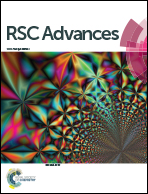Green remediation of textile dyes containing wastewater by Ipomoea hederifolia L.†
Abstract
Wild plant and tissue cultures of Ipomoea hederifolia decolorize Scarlet RR (SRR) dye at a concentration of 50 mg L−1 up to 96% and 90% within 60 and 96 h, respectively. Significant induction in the enzyme activities of Lignin peroxidase, laccase, 2,6-dichlorophenol indophenol reductase, superoxide dismutase, catalase and tyrosinase was found in the plant roots and shoots during decolorization. I. hederifolia was also able to treat a dye mixture and a real textile effluent efficiently with a reduction in the American Dye Manufacturers Institute (ADMI) value (color removal) up to 85% and 88%, BOD up to 65% and 63% and COD up to 62% and 68%, respectively. Detailed anatomical studies of the stem and root cells of I. hederifolia during uptake and degradation were carried out, showing a stepwise and mechanistic degradation of the model dye SRR. Products formed after dye degradation were analyzed by UV-Vis spectroscopy, FTIR, HPLC and HPTLC, which confirmed the phytotransformation of SRR, dye mixture and textile effluent. A possible pathway for the phytotransformation of SRR was proposed based on GC-MS analysis, which confirmed the formation of different metabolites with lower molecular weights. The phytotoxicity study revealed the non-toxic nature of the formed products.


 Please wait while we load your content...
Please wait while we load your content...